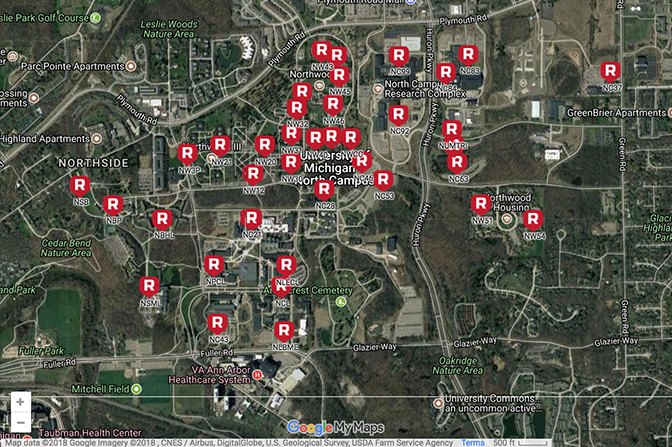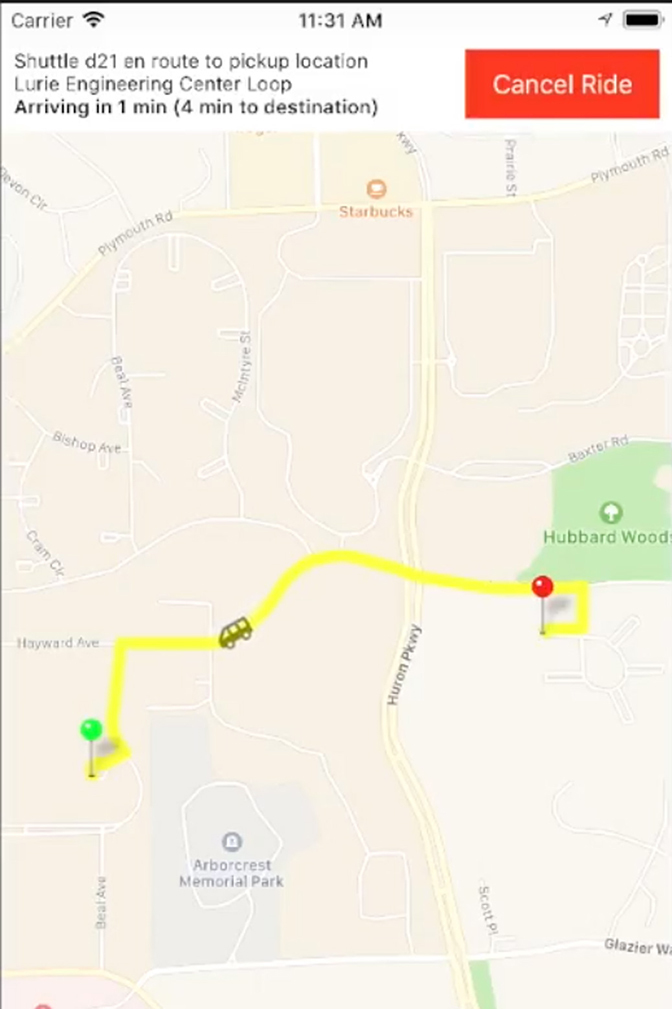U-M becomes first test bed for on-demand transportation system
Hail, hail a free ride on North Campus
Hail, hail a free ride on North Campus
A first-of-its-kind on-demand transportation system is being piloted at U-M as the RITMO Transit urban mobility system begins a limited test deployment on North Campus. RITMO, which stands for Reinventing Public Urban Transportation and Mobility, aims to mash up aspects of Uber-style ride sharing and fixed-route buses to form a more convenient, more efficient and less costly transportation system. This pilot is being conducted by Michigan Engineering; U-M Logistics, Transportation and Parking; and U-M Information Technology Services in partnership with Ford Motor Company.
About 100 test riders are using a custom-built smartphone app to hail free rides between pre-set stops in an area bordered by Plymouth Road, Fuller Road and Green Road. Riders are shuttled by professional drivers in a six-vehicle fleet of shared Ford Transit shuttle vans. The test is being conducted Monday through Friday from 7:00 p.m. to 11:00 p.m.

Slated to run for several weeks, this first deployment will focus on the ride-sharing aspect of the system. Its immediate goal is to hone the technology and gauge rider response.
“Nobody has seen anything like this before, so gauging rider reaction is our No. 1 goal for this first deployment,” said Pascal Van Hentenryck, the Seth Bonder Collegiate Professor of Industrial and Operations Engineering at U-M and the lead researcher on RITMO. “The data we gather will be a great help to us as we expand RITMO across North Campus and beyond in the months and years ahead.”
The next phase of deployment will include all of North Campus and several surrounding neighborhoods, as well as Central Campus and Michigan Medicine.
At that point,the system could significantly ease the parking crunch on Central Campus and Michigan Medicine by providing a convenient alternative to driving that entices more staff, students and faculty from surrounding neighborhoods to leave their cars at home.
“The cost to the university to build a single parking space on Central Campus is about $30,000, and most of those spaces are used by people who drive from less than five miles away and don’t use their cars during the day,” Van Hentenryck said. “We could use RITMO Transit to provide those people with a convenient ride that costs much less, for both the user and the university.”
Eventually, Van Hentenryck envisions the ride-sharing system as one component in a larger transportation system that combines hailable shared-ride service with a network of high-frequency buses. This “hub-and-shuttle” system could eventually expand across U-M’s campus and beyond. Van Hentenryck says the system could get riders to their destination in half the time of the existing bus system, at the same or lower cost.

“A bus costs many times more than a car, so high-capacity buses often aren’t the most efficient way to serve areas where demand is low,” he said. “Serving those areas with small, on-demand vehicles would be much more efficient and more convenient for riders.”
The core U-M system would remain free to users, though he believes that eventually, riders will be able to choose from several different transportation options for a given journey—some free, some not. The user data collected in this test rollout will be used to inform the later stages of RITMO, helping the team tailor the model to riders.
“From a data science standpoint, this is a fascinating optimization problem,” Van Hentenryck said. “What are the mobility patterns in Ann Arbor? How do you define the size of the fleets. Where do you put the high-frequency buses, and how many? Those are the kinds of questions we’re answering with the data we collect in this initial part of the study.”
Other U-M departments involved in the project include the U-M Transportation Research Institute; the Department of Emergency Medicine; the Taubman College of Architecture and Urban Planning; the Department of Electrical Engineering and Computer Science; U-M Logistics, Transportation; and Parking and Advanced Research Computing – Technology services. Development of the system is funded with a $1.4 million grant from the Michigan Institute for Data Science (MIDAS) and the Seth Bonder Foundation.